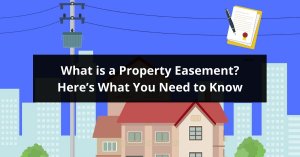Your offer got accepted, and then they drop the news on you. There’s an easement on the property. At first, it may seem like an intrusion, but ultimately, it’s not all that bad. You may hardly notice anything at all.
A property easement is a nonpossessory right to use or enter a piece of property for a specific purpose. It does not give anyone the right to use your property for any other purpose than is explicitly stated.
Easements are typically issued for two reasons.
- The most common cause is to allow utility companies to access and maintain power lines.
- Otherwise, an easement is commonly granted to enable another landowner to travel across your property to access the main road.
In any case, it does not grant any individual access to your property in its entirety. There are some instances where it may allow construction on your property, and you will need to pay careful attention to this.
There are many other possible reasons for an easement to be granted on a piece of property. Different types of easements are issued because of this. For example, an easement granted to a utility company is not the same that will appear when another property owner simply needs access to roadways.
Understanding how one will use your property becomes very apparent once you know the different types of easements.
Types of Easements
- Utility Maintenance – If a utility company needs access to your land to perform certain functions, they may attain an easement to do so. They may acquire one to access water lines that run through your land. It can also be used to run power lines to other pieces of property. In any scenario, it will likely have little impact on your day to day living.
- Private Easement Rights – Private easement rights grant another landowner the right to use your property for a specific reason. This type of easement is most commonly used to allow another property owner the right to use your property for a driveway but is not limited to this purpose. It’s essential to find out precisely what easements exist on a property as you purchase it to know what to expect.
- Easement by Necessity – Like Private Easement Rights, an Easement by Necessity may be attained by another landowner to use your property for a specific purpose. For example, if the only way to access the main road is by traveling across your property, this easement can grant an individual to do so.
- Prescriptive Easement – In the case that you’ve been using another piece of property for a specific purpose and a landowner denies you permission to do so, a prescriptive easement may be granted. Most commonly, this is used to continue to allow individuals to use driveways on another piece of land by permission of the law.
Now that you know the types of property easements, here are some commonly asked questions and answers about them.
Is it bad to have an easement on your property?
It is not always bad to have an easement on your property. They may impact property value in some instances, but this can only be the case if a significant portion of your land is affected by an easement or if it has strict guidelines, the landowner must follow. This is rarely the case, but if power lines, sewer lines, or roadways pass through the property, you must be aware of the guidelines.
What is an example of an easement?
A utility company may need to access your land to install or maintain telephone poles and power lines. They can attain an easement that grants them the right to do so. Additionally, neighboring landowners may acquire an easement to use a road on your driveway if it is their only access to a public road.
What is an easement in real estate?
An easement is a nonpossessory right to use or enter a piece of property for a specific purpose.
Do you have to give someone an easement?
No, you do not have to grant someone an easement. After all, it is dealing with your private property. However, this may lead to a court date. If the easement is considered beneficial to the community, the Judge will likely grant it.
Who is responsible for maintaining an easement?
The owner of the easement is responsible for it. The landowner is responsible for maintaining the land, and that is all. If the easement holder’s property is damaged by no fault of another, or if they cause damage to the property they are accessing, it is their responsibility to cover the associated costs.
How do you value an easement?
The value of an easement is determined by how much the landowner has lost from the rights granted. In other words, the impact it has on the burdened property.
To determine easement value, the land must be appraised for its total value. This is known as the Before Value. You must estimate how much of the property is impacted and subtract it from the Before Value. What is left is known as the After Value.
After subtracting the After Value from the Before Value, the Remainder will be the total value of the easement.
How are easements created and dissolved?
Easements are created either by a transfer of a deed or another document, such as a contract or will. How they dissolve can be somewhat confusing. Some may go on forever or until the necessity they were created ceases to exist. Easements may also last until completion of the task. Others may only be granted for a set period, and when the time limit is met, the easement will dissolve.

